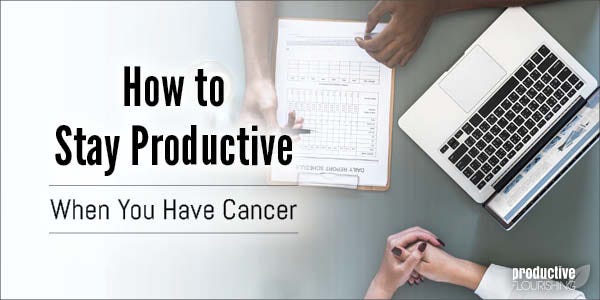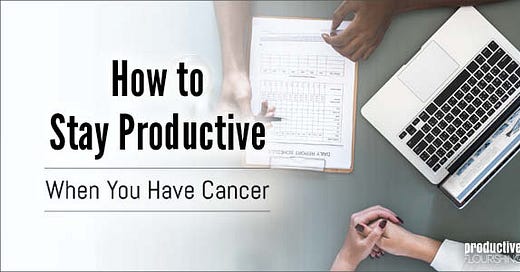How to Stay Productive When You Have Cancer

Editor’s note: This is a guest post by Nancy Seibel.
By the time my doctor entered the ultrasound exam room, I knew something was wrong. And I was right—something was cataclysmically wrong. She said, “I strongly suspect you have cancer.”
Her words plunged me into an alien landscape some people call “Cancerland.” Cancerland is a parallel universe in which everything still looks deceptively familiar. The foundation of reality, though, is profoundly different, with its own rules, language, and rituals.
I knew nothing about Cancerland. The first thing I had to do was get my bearings. It started with reconciling the new me, a woman with a life-threatening disease, with the old one, an energetic, healthy, and active person. Even as I was doing this I had to tell those closest to me. It was hard. I had to manage not only their emotional responses but also my own.
Of course, thoughts of work surfaced, too. Would my solopreneur coaching and consulting business survive my cancer diagnosis? And if it could, how?
Shifting from Growth to Stability
Charlie Gilkey helped me find a way. We’d already been working together for several months, focused on growing my business. When the doctor told me the news, I wondered if I should cancel my next coaching session with him.
I didn't. Instead, I told him what was going on. I thought he might be able to help me think through how to approach my business. He did. Charlie was his wonderful self: understanding, humorous, respectful, and helpful.
He was also personally knowledgeable. I knew, from listening to the Productive Flourishing podcast, that he and his wife Angela Wheeler had experienced serious injuries and life-threatening illnesses. Charlie wasn’t just giving good recommendations. He knew what I was going through.
Because of that, he was able to help me shift from a growth mindset to a stability one. He also helped me rethink productivity, framing it within the context of Cancerland. All of that helped me feel anchored and focused.
Rethinking Productivity
But reaching that point meant letting go of current expectations for myself. I had to create a new business plan that included time for disease “project management,” i.e., handling logistics for appointments and potential side-effects.
Planning my days that way wasn’t entirely unfamiliar. Charlie and I had had previous conversations about productivity. He always emphasized I should create a schedule with blocks for focused work and blocks for rest and renewal in order to stay productive.
I listened to his advice and decided my current situation called for a schedule where self-care came first. If I prioritized it, then I’d be more focused and productive during my business hours.
To help with that, I framed my plan in four categories: what to stop doing, what to keep doing, what to start doing, and what to ask for help with. I’ve included a few examples for each category to help people who may be coping with an illness while trying to run a business.
1. What to Stop Doing. I knew some activities would drain my energy and adversely affect my professional and personal life during my cancer treatment, so I:
Withdrew from most community volunteering efforts.
No longer attended networking meetings and events.
Put on hold securing new clients or contracts.
2. What to Keep Doing. To keep my business stable, I still needed to deliver excellent service to existing clients, so I:
Informed clients and colleagues about my diagnosis.
Provided one-on-one coaching sessions to current clients.
Sent my weekly newsletter to subscribers.
3. What to Start Doing. Charlie helped me identify activities I could start doing even when experiencing bouts of fatigue or other physical side effects. Thus, I was able to:
Start a Facebook group to establish, grow, and stay in contact with my community.
Create a bank of blog posts while I felt well so that I could “withdraw” and schedule them on the days I didn’t.
4. What to Ask for Help With. I knew I’d need a community of people supporting me in the weeks and months to come, so I:
Requested people to submit guest blogs for my website.
Shared my login information with a trusted person (my husband).
Joined an online writing group for support and encouragement.
As I wrote my plan, I recognized it was more of a guide to help me do my best. I did not have to implement all of it to be productive or successful. In fact, I didn’t use all of it. The bank of blog posts was a great idea in theory but not in real life. However, because I’d asked for guest posts and cut back on my blogging schedule, I was still able to keep my business productive and visible during my months of treatment.
Finding My Stride Again
Both my business and I are doing well 11 months after completing treatment. My productivity varied during those months, but it stayed relatively steady because of my plan. The plan helped me maintain a positive sense of my capacities and focus on the future.
It also gave me a sense of hope, purpose, and possibility at a time when it would have been all too easy to get mired in the not-so-great present. The entire experience reoriented me. I no longer fret over what I can’t know and celebrate what I do know: I want to live each day as if it matters, because it does. (Tweet this.)



